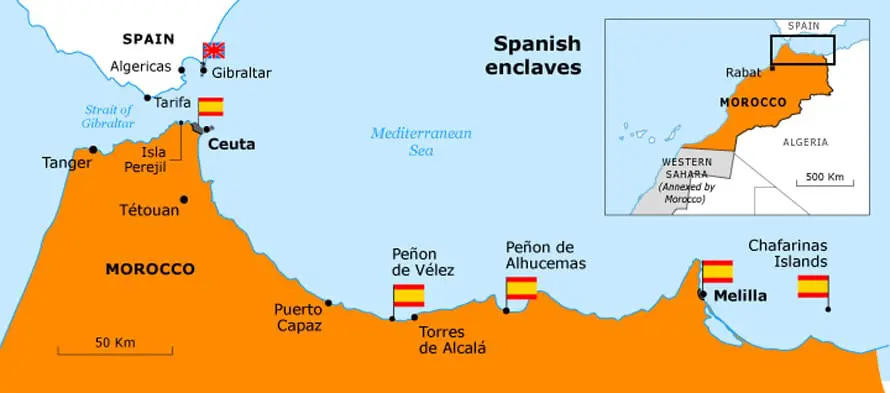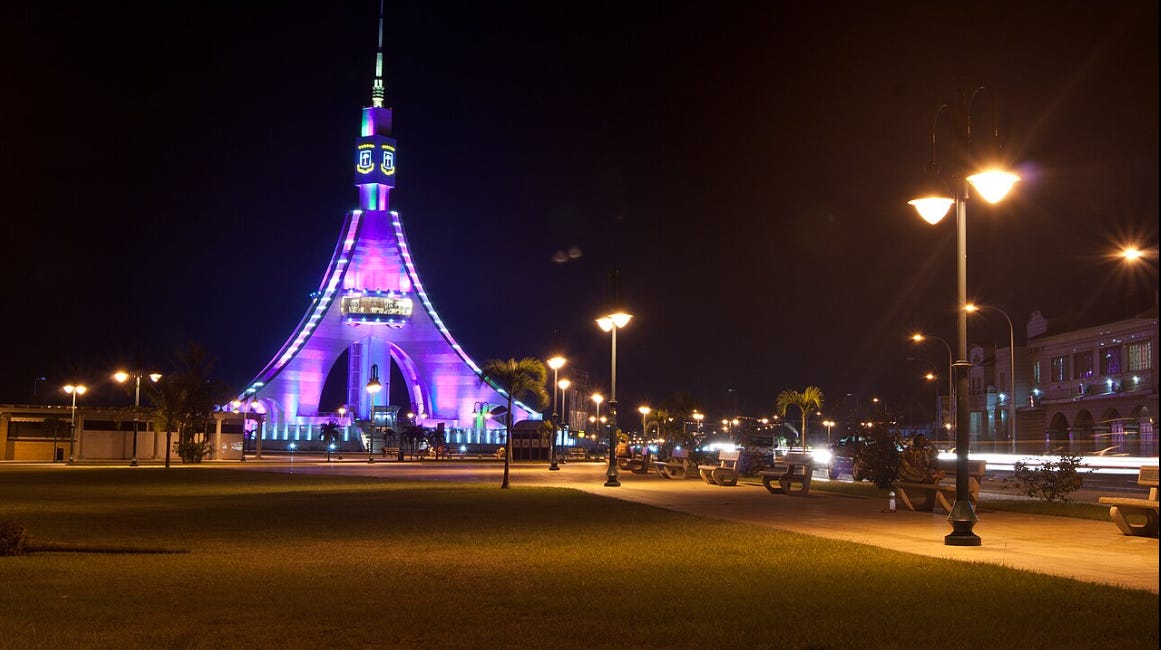A Series on all of Spain's Colonies in Africa
Spain retains control over some territories that are in Morocco's periphery
Spain didn’t just colonize Latin America and the Philippines. Spain had a few territories/colonies in Africa: Ceuta, Melilla, the Sovereignty Strongholds —“Plazas de Soberania”, the Canary Islands, North & South Morocco/Western Sahara, and Equatorial Guinea. Below you will see Spain’s former colonies and current territories in Africa on the map below.
To this day, Ceuta, Melilla, the Sovereignty Strongholds, and Canary Islands are part of Spain.
Western Sahara is a disputed territory between the Sahrawis and the Moroccans.
Morocco and Equatorial Guinea are now independent nations.
The Canary Islands
The Canary Islands are a bunch of northwest African islands that are part of Spain. There’s over 2M people who live there. The average person in the Canary Islands makes roughly $20K a year, meanwhile the average Spaniard makes roughly $32K a year ($46K if you adjust for purchasing power parity).
If the Canary Islands were an African country, the archipelago would be the richest African Country.
Chunks of Morocco
Morocco used to be a powerful empire prior to Spanish colonialism. But the 15th century was when Morocco started losing territory:
Below you will see Spain’s territories that are inside Moroccan land.
Ceuta: Morocco lost its port city, Ceuta to Portugal in 1415. This event is important in human history, as this marks the moment when the Portuguese Empire began and when Portuguese became more powerful than the Berber-Arabs. By 1668, King Afonso of Portugal ceded Ceuta to King Carlos of Spain in the Treaty of Lisbon. Morocco has tried to get back Ceuta multiple times and failed. The average Ceutan makes $24K a year. The people there speak Spanish and Moroccan Arabic - Darjia.
Melilla: Melilla is the second enclave that is Spanish territory that is inside Morocco. Spain conquered it in 1497 from Morocco and still has it today. The average Melillan makes $22K a year.
Sovereignty Strongholds: Spain took these islands from Morocco in 1492.
Spanish Morocco: In 1912, France and Spain carved up Morocco. Spain took Northern Morocco and Southern Morocco/Western Sahara, while France took Morocco proper.
Even to this day, Morocco wants ALL of these territories back. The King declares that Western Sahara, Ceuta, Melilla, and the Strongholds of Sovereignty should be Moroccan land and that acknowledging otherwise is just accepting European imperialism. Spain has ignored Morocco’s claims of these lands except Western Sahara. Unfortunately for Morocco, right now Ceuta and Melilla like being a part of Spain.
Western Sahara/Southern Lands of Morocco
If you want to learn more about the Western Saharan (and Morocco) conflict you can click on my Moroccan article below.
But the TLDR, Spain relinquished claims in 1975. Morocco, Mauritania, and the Algerian-backed natives of Western Sahara fought a war. Morocco annexed the territory but very few nations recognize Moroccan sovereignty over the areas. On December 10th, 2020, President Donald Trump recognized Moroccan sovereignty Western Sahara, This was a "“quid pro quo”. In the Abraham Accords, Morocco recognized Israel in return for American & Israeli recognition of Moroccan sovereignty over Western Sahara. Spain also backs Moroccan rule, as long as Western Saharans have some autonomy.
The Moroccan-Israeli agreement was a big deal because Morocco used to have ~300K Jews in Morocco (10% of the Moroccan Population)prior to the state of Israel. Due to deadly riots in Morocco and discrimination(Push factor) and the creation of Israel (Pull factor), the vast majority of Moroccan Jews went to Israel. Israel had an operation called Operation Yachin where Mossad (Israeli Intelligence Operations) made a secret deal with the Moroccan King to migrate Jews from Israel. Mossad paid money to Morocco to get the Jews to leave Morocco and go to Israel for save haven.
The Geopolitical & Economic History of Morocco
Morocco is a semi-constitutional monarchy (meaning, the King shares executive power with the prime minister) and has 38M people who live in the country. Morocco is 95% Arab-Berber. It is classified as a lower-middle income country by the World Bank and has
Morocco is a lower-middle income country that is expected to become upper-middle income by 2030.
Equatorial Guinea
After independence, Equatorial Guinea became African Cambodia until the President’s nephew took over and found oil in mid 90s. The nation’s economy had a meteoric rise and made a splurge of mega projects & investments which made roughly a third of the country well off, while the other two-thirds are still mired in poverty. The country is a family run petro-state and it is a deeply unequal upper middle income country. You can read my article on Equatorial Guinea below:
If you had to compare incomes between Equatorial Guineans and Moroccans, Equatorial Guineans are slightly richer due to oil & gas wealth, although Equatorial Guinea has deep inequality. See chart below for income comparison:

In terms of industrialization, Morocco is more developed. Morocco makes billions exporting clothes, aerospace parts, cars, wiring, fertilizer, and phosphoric acid while Equatorial Guinea is a petrostate.
Morocco will probably never give up wanting lands in Morocco to be… part of Morocco. Right now Spain has 47M and Morocco has 37M. Morocco’s GDP is 134 Billion while Spain’s GDP is 1.4 Trillion. Morocco needs to become a lot more developed if it wants those enclaves back.
Spain exports 9x more than Morocco. Spain has firms like ITP Aero that makes jet engines and steel firms like Arcelor Mittal. Spain exports $372B a year.
In terms of imports, Spain imports $410B a year, most of Spain’s imports come from other EU countries, China, and the U.S.
Equatorial Guinea sells $708M of oil & gas to Spain. But Spain doesn’t depend on Equatorial Guinea for oil & gas at all. Spain gets more oil & gas from other countries: Nigeria ($6.6B), America ($4.5B), Algeria ($4.4B), Mexico ($2.94B), Libya ($2.92B), , Saudi Arabia ($1.8B), and other countries.
Morocco mainly sells $8.53B textiles, electric wires, cars & car parts, and fruit to Spain.
Textiles: Moroccans make clothes for Spanish clothing firms like Zara or Mango.
Cars & Car parts: Spanish car firms like SEAT or Spanish component manufactures like Grupo Antolin invest in assembly plants Morocco at Tangier - Morocco’s low tax, economic zone. Moroccan workers assemble and export cars, car electronics, car windows, car seats, and car interiors to Spain. Then Spain does quality inspections, customize, do final assembly and then sell to European consumers or European manufacturing component buyers. Morocco is Spain’s cheap labor pool. Moroccan labor is 8.5x cheaper than Spanish labor. Thanks to proximity to Europe, decent infrastructure, and cheap labor Morocco is making electric vehicles, electric batteries, and hydrogen power cars for Europe. This has made Morocco the #1 Manufacturing hub in Africa.
Will Morocco or Equatorial Guinea surpass Spain or a former Spanish colony one day? It seems a pretty tall order, but let’s check again in a decade or two:
Here are their average incomes as of 2022 from the World Bank:
Average Spanish Incomes: $32K ($46K adjusted for PPP)
Average Mexican Incomes: $11K ($21.5 adjusted for PPP)
Average Peruvian Incomes: $6.7K ($15K adjusted for PPP)
Average Equatorial Guinean Incomes: $5.3K ($13K adjusted for PPP)
Average Moroccan Incomes: $3.7K ($9.4K adjusted for PPP)











Another fascination, especially about the enclaves. Readers dwindle in the 'holidays' but I've crossposted for later this month. Western Sahara deserves freedom!